Foundations of Lighting: Understanding Soft Light
| Soft Light Explained: | A soft light source would be one that appears larger in relative size than the subject being lit. Being larger than the subject, the light source is covering it from a greater angle and, as a result, filling in more of the potential shadow areas. |
| Hard Light vs Soft Light, in Nature & the Studio |
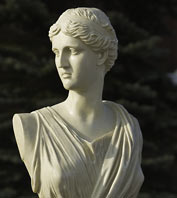 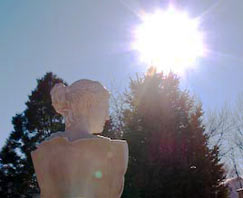 Outdoors, our subject is being lit by the sun, which, in reality, is much larger than the subject. But, since its so far away, it appears smaller and therefore is light quality will be "harder". Note the sharp shadows. |
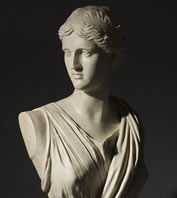 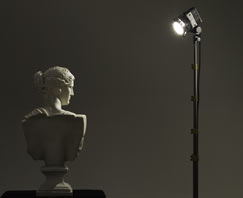 Indoors, our subject is being lit by a 250W Pro-light, which is much smaller than the sun, but also much closer. It still appears much smaller than the subject, and therefore is light quality will be "harder". These shadows are also sharp. |
 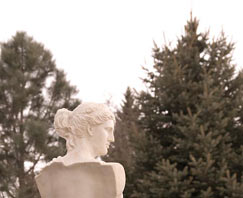 Outdoors, our subject is now being lit by the overcast sky. Unlike the "point source" effect of the sun, the entire white cloudy sky is now the light source. In relation to our subject, the source is much larger. It lights our subject from a very large angle, so its effect is ultra soft. Note how subtle the shadows are. |
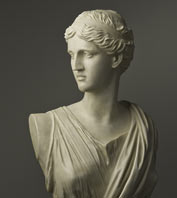 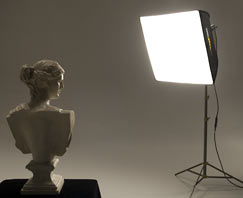 Indoors, our subject is now being lit by a 750W Rifa eX 66. While its not as large a source as the overcast sky, it is a much larger source than the Pro-light, especially when used this close. So the effect will be much softer than the Pro-light. Compare the shadows between Pro & Rifa. |
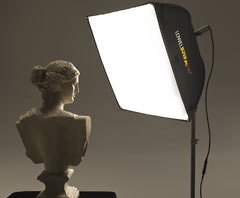 |
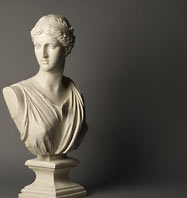 |
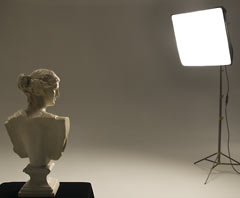 |
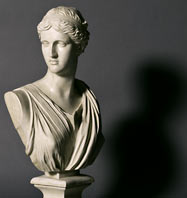 |
| While shadowless, or flat, lighting can be a legitimate lighting style, light that is too soft can rob an image of its sense of dimension and depth. The shot lit by the overcast sky is an example of this. Don't forget that your image is 2 dimensional, and you are giving the illusion of depth thru the creative use of shadows and contrast. These details are also what give the viewer clues about the form and textures in fabrics and food; or surfaces like weathered wood and rough stone. Lighting is not always either hard or soft. There is a whole range of creative possibilities in between these 2 extremes. Note the visible differences in the shadows behind the 2 statue images above. Moving the soft light back created a smaller source, making the effect of the output harder and the shadows stronger. Part of the process is developing a creative instinct for what level of softness you desire in a shot, the second half is achieving it. As you will see, there are some possibilities for that. |
| Softening a Hard Light |
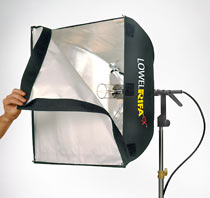 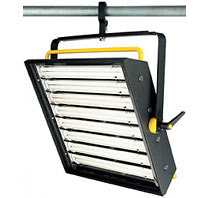 Some lights like the Rifa convert an installed hard point source lamp into a soft source. Others, like fluorescent light banks are already soft because their bulbs are larger and emit a diffused light. Both follow the same principles of relative size and diffusion to determine their degree of softness. There are other ways to make a hard light source softer. All involve techniques to make the light source appear to be physically larger. |
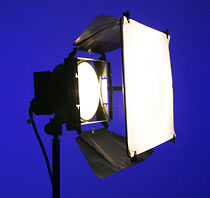 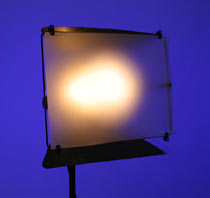 Using diffusion gel in a frame attached to the front of a hard light can soften it to some degree, by changing the small point-source size of the bulb into the larger size of the gel it's now illuminating. Using an even larger piece of diffusion material at a greater distance from the light will soften its output even more. A 1/2 thickness diffusion gel will produce a harder light than a full thickness gel, since it allows more of the light's original smaller point source to shine thru. |
| Softening by Reflecting |
| So far, we have seen how direct hard light sources, such as the sun or the small point source of a tungsten-halogen bulb, can be converted to soft sources by adding a large diffusion, such as overcast clouds or the front diffuser of a Rifa. Light is softened as it passes thru the diffusion. However, light souces can also be softened by reflecting or bouncing their output. In this case, the reflector's surface becomes the light source, since it is the light bouncing from it that now illuminates the subject. As a result, the size of the reflector surface determines the softness of light. The less specular (or mirror-like) the reflector, the softer the reflected light. Be aware that when you bounce light, you will lose output. The beam is now traveling the greater distance, from fixture to reflector, to subject. |
| Umbrellas |
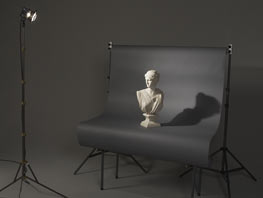 Adding a reflective silver umbrella accessory will convert the source size of this small Pro-light from three inches to twenty seven inches, the size of the umbrella. The newly larger source noticeably opens up the shadow areas. Notice the difference in shadows in the 2 wide setup shots. |
 Notice, also, the amount of reflected spill the umbrella adds to the surrounding area. Soft light is harder to control, as its larger source covers a wider area. Discreetly placed flags can provide some help, but they need to be big to do the job. Moving the subject away from walls will help too. |
| In addition to silver, there are also white nylon umbrellas available. The difference in effect is subtle, with the silver having a slightly harder reflective output than the white nylon version, since its silver threads a more specular & therefore will have more reflective highlights. The advantage of a white nylon umbrella is that you can also turn it around & light thru it, using the translucent nylon as a large diffuser. Its not as efficient as a Rifa, since some of the output is being reflected backwards and away, but in a pinch it can be an easy solution. If using white nylon umbrellas with focusing lights, always make sure to focus the light to flood, or you may melt a hole thru the umbrella. |
| Bounce Reflector Card |
| The technique of bouncing the output of a light, like a Tota, off a white ceiling or wall to bring up the ambient light level in a room is well known. Done right it converts the ceiling or wall into a larger and softer light source. If used incorrectly you might just be adding more light from an unflattering overhead angle. Reflective panels like this piece of foam core and other color neutral materials can be used to give your bounced light a similar quality while allowing you some control of the direction of the light. To get the maximum amount of softness use as large a reflector as you can and position it far enough away from the light source for the beam to cover the entire surface. In this case, the large piece of foam core is being held to the KS Stand using a Lobo clamp and a Maxa-mount arm. |